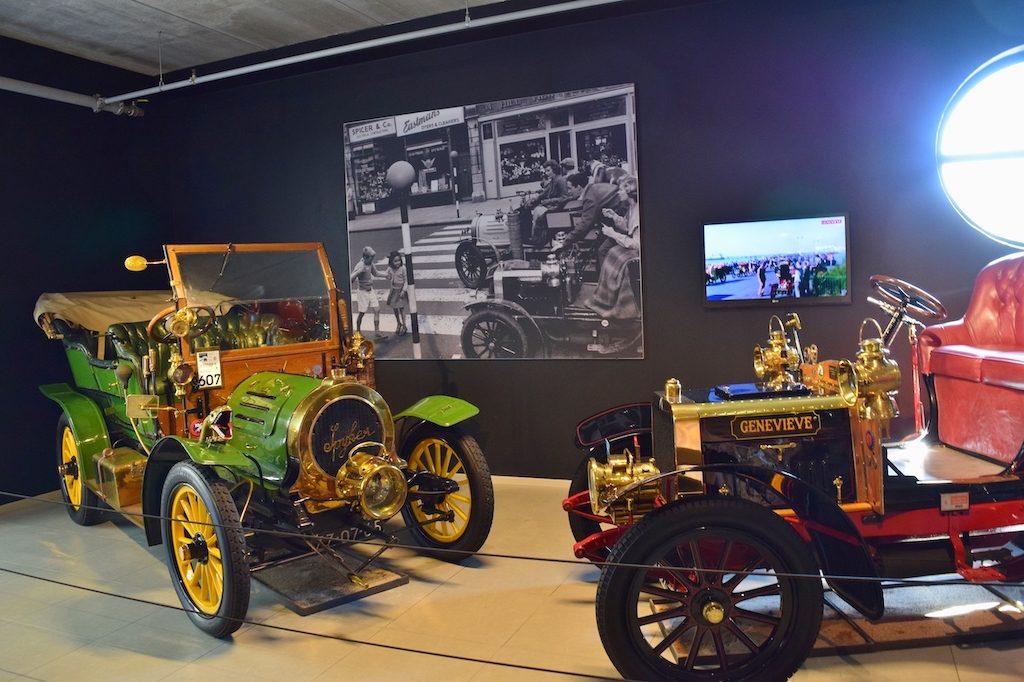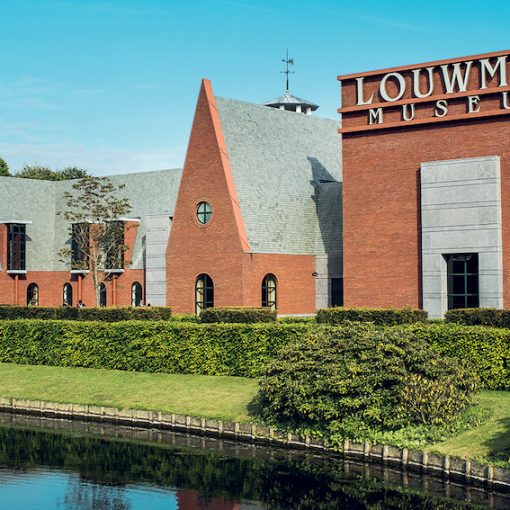Richard has already written about our trip to the Netherlands this spring (see: ‘Going Dutch‘). The trip was not only fun, but educational.
For example, why do I often refer to Holland as The Netherlands? Well, it turns out that The Netherlands comprise twelve provinces and North and South Holland are just two of them, but probably the most important.
And did you know that the Dutch are, on average, the tallest people on the planet? This fact was demonstrated to your scribe when some of our party visited the renowned Louwman Motor Museum in The Hague.

The museum is housed in a purpose-built facility located in a park adjacent to the Royal Palace, enclosed by a canal and virtually hidden from its surroundings by beautifully designed landscaping.
It was founded in 1934 by Pieter Louwman – the official Dodge and Chrysler importer – with the purchase of a twenty year-old Dodge motor car.
The collection has been at its current address since 2010 and focuses on vehicles of historic value. It also includes motorcycles, bicycles, carriages, automobile art, and even a plane or two. All are totally original, some unique, and they range from super luxury to affordable family runabouts. And all have a story to tell. So, let’s get in there and take a look.

Upon entering we were waved away from the public car park and lined up in front of the main entrance. Now that’s what I call service!
The Reception Hall itself was amazing, containing an eclectic array of exhibits which included a prototype Daf Daffodil, complete with its then revolutionary Variomatic transmission, a Shanghai SH 760 from the 1980s – think 1950s Mercedes – a 1948 Tatra 87 from the Czech Republic, a Steyr Type 55 Baby (Ferdinand Porsche’s forerunner of the Beetle), a Lancia Astura of 1937, its flowing Art Deco lines penned by Farina, and a 1952 Jaguar XK120 fixed head coupe.
More recent were a Volvo PV444, a Citroen DS, a Toyota 2000GT and a Corvette 427 Stingray from 1966.
But take a look at probably the wildest exhibit in the museum, the Lincoln Sedan Delivery Deco Liner with a Harley Davidson Sportster Deco Scoot. What a hoot! Clearly inspired by the streamlined designs of Figoni and Falachi, or maybe Scoutchik, of the 1930s, this apparition hints at the lines of the Lincoln Zephyr of that era and is one of the best custom jobs that this writer has seen. All this to carry your motor bike in style. Hmmm.

A quick trip in the lift brought us appropriately to “The Dawn Of Motoring” – some lift. Here we were greeted by a horse-drawn wagon overlooked by a painting of a very similar device, but the latter was painted 200 years before the former was built. Pretty slow progress don’t you think? Well, the internal combustion engine soon put the metaphorical hammer down.
Within this section we were whisked from the early pioneers of the late 19th century to the Roaring Twenties, taking in such delights as: an 1887 De Dion Bouton steam quadricycle, an 1899 Panhard et Levassor type A1 double phaeton and a Buffum Stanhope of 1895, the world’s first 4-cylinder car – American of course. (They also produced the world’s first production automobile fitted with a V8 engine).
I have merely scratched the surface of this section, so apologies for the lack of detail and the haste but, before moving on, let’s see a few more gems.

What better to see but a totally unrestored 1895 Panhard et Lavasser phaeton with capote? There were more phaetons here than you could shake a stick at and the P&L company were one of the oldest manufacturers in the world, producing a choice of twenty models.

This 124 year-old, Paris–built, time-warp example looks ready for the London to Brighton run. Speaking of which – what a Segway! – yes, the 1904 Darracq 12HP “Genevieve” was also on display, complemented by the home-grown Spyker 12/16 HP double phaeton driven by Kenneth More in the film ‘Genevieve’.
Another Darracq nestled nearby, this time much smaller – an 8 HP two-seater from 1901.
And finally, where would we be without a curved dash Oldsmobile Model R runabout? Not the rarest of vehicles, as they made 11,000 before production ended in 1907, making it America’s first volume production car. This one dates from 1903.

Space dictates that we must now move on, but not before we’ve had a coffee.
Remember my remarks about the height of the Dutch people? Well, nowhere was this more evident than in the museum’s reception hall which, by no, was playing host to an insurance convention with slender white tables groaning under the weight of white wine bottles and each surrounded by executives rapidly quaffing their contents from delicate glassware. The place was packed with people so tall that they were in danger of starting a solar eclipse. Even Richard was beginning to look small.

We eventually made it into what was effectively a replica of a 1920s/’30s Dutch street, complete with a hotel, a TV/radio repair shop, a chemist, a cake shop, a garage, several other commercial properties and, most importantly, a café which was not fake. Sitting at a table in the “street” you could see the “sky” from which hung the basket of a hot air balloon, and the passenger compartment of an airship. Fascinating.

The next floor was divided by an atrium which enabled us to look down on a selection of the Netherlands’ own Spyker cars. A 14/18 HP double phaeton and a C1 13/30 HP Torpedo Touring were amongst the best.
This section contained a real mix of vehicles with a timeline ranging from the ‘teens, to the twenties, thirties, forties and each decade up to the seventies.
I didn’t count the ’85 Trabant. Displayed individually or stacked sardine-like, there were some interesting exhibits to dwell on with the likes of: a 1930s Ford cabriolet, a 1934 Chrysler Airflow 8 sedan, an Amphicar , an NSU Prinz, a Triumph Renown and two rare Lloyds – an LP300 and an LT600, the latter a sort of early MPV.
A Honda S800, a 2CV, an Opel Olympia and many more were also crowded into this section.
Not all displays had four wheels, however. For the museum boasted a gallery dedicated to automobile art – drawings, sculptures, paintings and posters, from the Art Noveau and Art Deco periods.
The drawings and paintings took my breath away, particularly those of Fredrick Gordon Crosbie. Take in the movement, drama and humour that he managed to capture almost effortlessly. He also penned the Jaguar Leaper design for William Lyons.
There were many sculptures on view, but it is those by Rene Lalique that always catch my eye and none more so than “Victoire” which does it for me every time. Often used as a radiator mascot, it’s to die for.
There were some excellent stylised studies of 1930s automobiles, intricate scale models, winners’ trophies, chinaware and even a Batmobile – or was it the 1957 Lincoln Futura sitting in that glass case?
Electric cars are for the future and are rapidly becoming the present but, back in 1905, Hedag electric broughams were humming along the streets of Hamburg and Berlin, being used as taxis. And there were more; a 1912 Baker Coupe and a Detroit Clear Vision Brougham of the same year were also early EV’s, but not as early as the 1899 Columbia electric landaulet which was used to transport VIP’s across New York at the turn of the century. Looks like a horseless Hansom Cab which it probably was.
A 1942 Bregnet A2W was displayed as found. One of only 200 produced, it had languished in the garage of a French chateau for 64 years.

Finally, it would seem that hybrids have been around much longer than you may think. Take a look at the Woods Dual Power of 1917, one of only two left in the world. It took another 80 years for Toyota to come up with the Prius.

That’s all we have space for this month and it’s time for lunch. See you next time when we will drool over luxury sedans and show cars, coach-built glamour, Americana, bubble cars and some outright weird inventions.
Neil Shanley
































